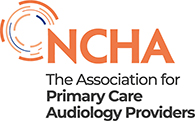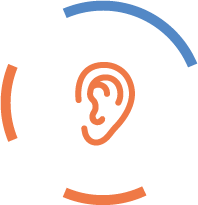Overview
Preventing the onset and impacts of health conditions on individuals, families and society is widely seen as good public policy. Prevention efforts however tend to focus on delaying the onset of a disease or condition rather than reducing its impacts.
As our population grows older it will not always be possible to prevent conditions such as age-related hearing loss, but we can do more through early diagnosis and management to reduce the impacts of these and other long-term conditions.
Reframing prevention priorities therefore provides policymakers and commissioners with new opportunities to prevent the impacts of unsupported hearing loss on individuals and wider society.
This section sets out the key prevention opportunities commissioners and policymakers in the UK can explore in audiology.
- Primary prevention focusses on pre-emptive action - e.g. stopping somebody developing hearing loss or ear disease
- Secondary prevention focusses on mitigation - e.g. once hearing loss or ear disease is present the goal is to reduce the risk of further decline
- Tertiary prevention focusses on minimisation - e.g. minimising the impacts of hearing loss on general health
Prevention opportunities in audiology
Opportunities in primary prevention
- Expand and promote the role of audiology in preventing noise-induced hearing loss (NIHL) from occupational, recreational and other sources
- Regular independent hearing checks for high risk occupations
- Ear protection for non-occupation noise exposure - e.g. high-risk sports
- Safe listening campaigns
- Early diagnosis and referral of ear conditions where hearing loss might be prevented
NIHL is the leading cause of preventable hearing loss. It is widely accepted that regular and prolonged exposure to loud noise (>85 dB (A)) can result in NIHL, with the risk of NIHL increasing significantly if noise levels increase above 90 dB (A) [1].
Although impulse noise - e.g. explosives - can cause permanent hearing loss, NIHL is typically due to chronic exposure to loud noise. NIHL is therefore typically slow in onset and noticed only after irreversible damage has occurred to the cochlea [2].
The primary goal is to assess and reduce risk primarily through limiting exposure to excessive noise and providing suitable ear protection.
Risks can be divided into two broad categories:
- occupational noise exposure and
- non-occupational noise exposure (e.g. recreational noise, gunfire/blast injuries) [3]
Occupational noise
The main sectors affected include agriculture, construction, quarrying, mining, transport, forestry, drinks and packaging, textiles, potteries, glass, rubber, printing, metalworking, woodworking, steel, entertainment, and the armed forces [4].
The Control of Noise at Work Regulations 2005 came into force 6 April 2006 [5] and require employers to reduce the risk to employee health from exposure to noise at work [6]. For example, employers are required to:
First: prevent noise at source
- ensure exposure to noise is eliminated at source, or if that is not reasonably practicable reduce it to as low a level as reasonably practicable
- ensure a programme of organisational and technical measures (excluding hearing protectors) are established where employees are exposed to noise at or above the upper exposure action value [7]
Second: provide hearing protection
- provide all employees with ear protection upon request if after addressing noise at source exposure to noise is at or above a lower exposure action value [8]
In addition, employees might be eligible for hearing checks as part of health surveillance. For example,
- if a risk assessment indicates that employees are at risk of hearing loss due to noise exposure then they should be under suitable health surveillance, including testing of their hearing [9]
- employees should be made aware of their entitlement to health surveillance including hearing tests [10]
- if such health surveillance identifies hearing damage the employer is then required to ensure a doctor examines the employee to establish whether that damage is due to noise exposure
In the UK two different agencies oversee the regulations cited above, these are Health and Safety Executive (Great Britain) and Health and Safety Executive Northern Ireland.
There is limited good quality data on the number of UK adults exposed to excessive noise levels (>85dB(A)) at work. For example, it is often suggested that 1.1 million adults in the UK are exposed to excessive occupational noise levels, but this figure is based on data from 1995 and the HSE itself accepts that since then employment patterns have changed significantly [11].
Although NIHL has historically been a leading cause of work-related injury compensation claims [12], in recent years recorded occupational NIHL cases have fallen from 200 per year to less than 100 per year [13]. This change might be due to a combination of more effective prevention and a decline in high risk industries [14].
Non-occupational noise
Although there is limited good quality evidence that non-occupational noise exposure will significantly increase the prevalence of NIHL, the World Health Organization (WHO) cautions that sources such as traffic and personal music players present a significant risk - e.g. the WHO warns that nearly 50% of people aged 12 to 35 in middle and high income countries are "exposed to unsafe levels of sound from the use of personal audio devices and some 40% of them are exposed to potentially damaging sound levels at clubs, discotheques and bars" [15]. The WHO has also cited studies which suggest that in recent years the prevalence of hearing loss among those aged 12 to 19 has risen from 3.5% to 5.3% [16], but it is unclear whether this increase is due to noise or other factors - e.g. socioeconomic status.
Nevertheless "safe listening" campaigns have been broadly supported, and although most countries do not have legislation to control recreational noise exposure, the European Commission issued a Directive in 2009 that set maximum output levels of new audio devices including safety features that warn users about hearing loss [17].
Advice on reducing the risk of non-occupational noise exposure typically involves advising the public to
- have regular hearing checks
- keep the volume down
- use well fitted earplugs
- use noise-cancelling earphones or headphones
- limit the time spent engaged in noisy activities
There are also specific groups at higher risk of NIHL, these are people that have hobbies which expose them to excessive noise.
Opportunities in secondary prevention
- Expand and promote the role of audiology assessments high risk groups - e.g. to detect and manage hearing loss and/or ear conditions in people at greater risk of worsening disease/disability
- Promote the benefits of early diagnosis and referral to prevent permanent hearing loss, ear disease or other morbidities. For example, allowing audiologists to refer directly to ENT and audiovestibular physicians
- Establish new monitoring services for people at risk of ototoxic hearing loss
Opportunities in tertiary prevention
- Implement the NICE guideline on adult hearing loss which promotes the early diagnosis and treatment of hearing loss to improve health and wellbeing, especially in older people who suffer from age-related hearing loss. This can help reduce the risk and cost associated with unsupported hearing loss, including social isolation, increased levels of unemployment, mental health problems and increased risk of dementia [1]
Originally published: September 2020
Reviewed: NA
Next review date: September 2021
Reference and notes
[1] NICE, 2018, Hearing loss in adults: assessment and management, https://www.nice.org.uk/guidance/ng98
More information on NIHL
[1] HSE, 2005, Final regulatory impact assessment of The Control Of Noise at Work Regulations http://www.hse.gov.uk/noise/noise.pdf
[2] HSE, 2008, Epidemiological evidence for the effectiveness of the noise at work regulations, RR669
[3] Others include environmental noise and its impact on general health. This however is a public health challenge managed by Public Health England and others. Noise being recognised, for these purposes, as a form of pollution. It is not included in this paper
[4] Explanatory memorandum to the control of noise at work regulations 2005. 2005 No. 1643
[5] The Control of Noise at Work Regulations 2005. The Regulations transpose European Directive 2003/10/EC into UK legalisation. The Directive 2003/10/EC consolidated and repealed the existing EC Noise Directive 86/188/EEC which was implemented in the UK using Noise at Work Regulations 1989 (Source: Explanatory memorandum to the control of noise at work regulations 2005. 2005 No. 1643). Except that for the music and entertainment sectors they came into force 6 April 2008 and there were also some exemptions for master and crew of seagoing ships until 6 April 2011 (Source: the Control of Noise and Work Regulations 2005)
[6] HSE, on behalf of DWP, 2005. Control of Noise and Work Regulations 2005
[7] "upper exposure action value" means the higher of the two levels of daily or weekly personal noise exposure or of peak sound pressure set out in regulation 4 which, if reached or exceeded, require specified action to reduce risk", Source: the Control of Noise and Work Regulations 2005
[8] "lower exposure action value" means the lower of the two levels of daily or weekly personal noise exposure or of peak sound pressure set out in regulation 4 which, if reached or exceeded, require specified action to reduce risk", Source: the Control of Noise and Work Regulations 2005
[9] Regulation 9(1), Control of Noise and Work Regulations 2005
[10] Regulation 10(g) Control of Noise and Work Regulations 2005, which refers to Regulation 9 Control of Noise and Work Regulations 2005.
[11] HSE, 2005, Final regulatory impact assessment of The Control Of Noise at Work Regulations http://www.hse.gov.uk/noise/noise.pdf
[12] Association of British Insurers, in Explanatory memorandum to the control of noise at work regulations 2005. 2005 No. 1643
[13] HSE, Noise induced hearing loss in Great Britain, http://www.hse.gov.uk/statistics/causdis/deafness/index.htm accessed 28 August 2019
[14] Health and Safety legislation since 1974 and specifically the Noise at Work Regulations 1989, have led to reduced employee exposure to noise at work, and advances in production engineering have meant more automated processes in the workplace with increasingly, separation of the worker from sources of noise. There have also been radical changes in employment patterns. Implementation of improved practice was not immediate but since the mid 1980s effective hearing conservation programmes have become widespread in industry (4). The overall number of employees exposed to very high levels of noise should therefore be declining, although in some occupations such as in the leisure industry, noise exposure has increased." DWP, 2002, Occupational Deafness, report by the Industrial Injuries Advisory Council. Cm5672
[15] World Health Organisation, 2015, Hearing loss due to recreational exposure to loud sounds: a review, ISBN 978 92 4 150851 3
[16] Shargorodsky J, Curhan SG, Curhan GC,Eavey R. Change in prevalence of hearing loss in US adolescents. JAMA. 2010;304(7): 772. 8. Cited in World Health Organisation, 2015, Hearing loss due to recreational exposure to loud sounds: a review, ISBN 978 92 4 150851 3
[17] Commission Decision of 23 June 2009 on the safety requirements to be met by European standards for personal music players pursuant to Directive 2001/95/EC of the European Parliament and of the Council (Text with EEA relevance)(2009/490/EC). Official Journal of the European Union, 2009, L 161/38-39 http://eurlex.europa.eu/LexUriServ/LexUriServ.do?uri=OJ:L:2009:161:0038:0039:EN:PDF Cited in, World Health Organisation, 2015, Hearing loss due to recreational exposure to loud sounds: a review, ISBN 978 92 4 150851 3

 Your hearing and aural health
Your hearing and aural health  Commissioners and Policymakers
Commissioners and Policymakers  Member support and guidance
Member support and guidance News and views
News and views
 Hearing map
Hearing map
